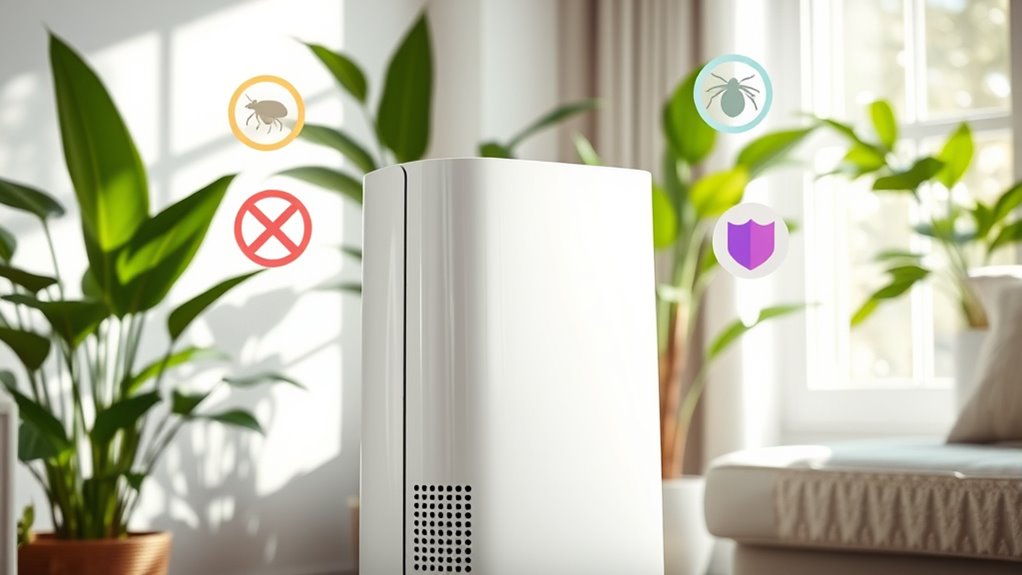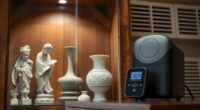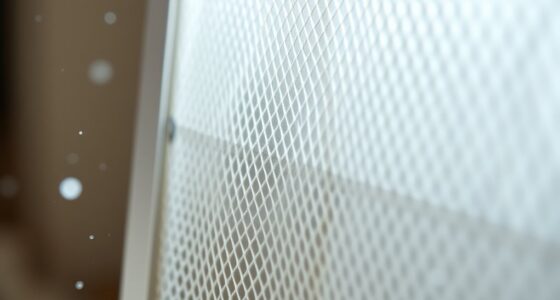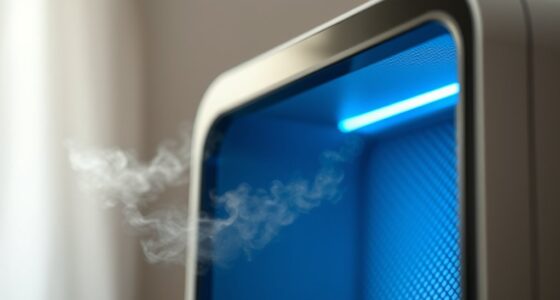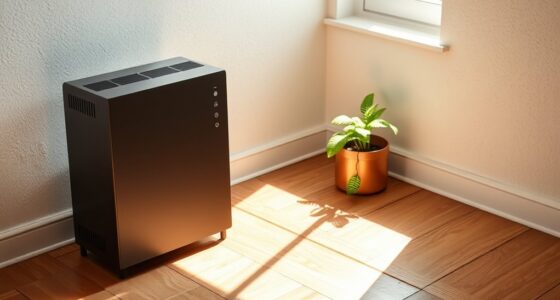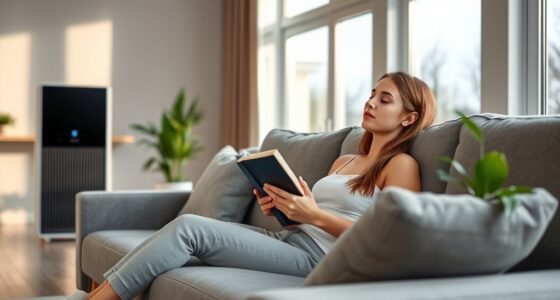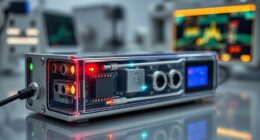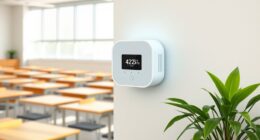Many common beliefs about air purifiers are misconceptions. Not all devices work equally—some use cheap filters, while true HEPA filters effectively trap tiny particles like dust and pollen. Ozone generators are harmful and shouldn’t be used indoors. Size matters; small units won’t clean larger rooms properly. To truly improve air quality, combine an appropriately sized purifier with good ventilation and source reduction. Keep exploring to uncover the facts that can help you choose smarter solutions.
Key Takeaways
- Not all air purifiers use true HEPA filters; check for certification to ensure effective removal of airborne particles.
- Ozone generators produce harmful ozone and should be avoided indoors due to respiratory health risks.
- Smaller or cheaper air purifiers are often inadequate for large spaces; size and CADR ratings matter.
- All air purifiers are similar; filter quality and technology significantly impact their ability to improve air quality.
- Using an air purifier alone isn’t enough; combine it with proper ventilation and source control for optimal indoor air health.

Have you ever wondered whether air purifiers really make a difference in improving indoor air quality? It’s a common question, and the truth is, many people have misconceptions about how these devices work and what they can do. One of the biggest myths is that all air purifiers are the same or that they can eliminate every airborne contaminant. In reality, the effectiveness of an air purifier depends heavily on its features, particularly filters like HEPA filters. These filters are designed to trap tiny particles such as dust, pollen, pet dander, and even some bacteria and viruses. When you choose an air purifier with a true HEPA filter, you’re considerably increasing your chances of removing the most common indoor pollutants. However, not all devices are created equal; some use cheaper filters that don’t meet HEPA standards, so always check for the correct certification.
Another misconception is that ozone generators are a safe or even beneficial alternative to traditional air purifiers. Ozone generators produce ozone, which is a reactive form of oxygen, in an effort to neutralize odors and airborne chemicals. While that might sound helpful, ozone is actually a harmful air pollutant when inhaled, and exposure can cause respiratory issues, worsen asthma, or lead to other health problems. Many health authorities strongly advise against using ozone generators indoors, especially in occupied spaces. They often give the false impression that ozone is an effective purifier, but in reality, it just disperses ozone molecules, which can irritate your lungs and damage your respiratory system. It’s better to stick with devices that use HEPA filters or activated carbon filters, which can trap pollutants safely without generating harmful byproducts. Additionally, understanding the importance of filter technology can help consumers select more effective and safer air purifiers for their needs.
People also believe that a small or inexpensive air purifier can handle all indoor air quality issues. But size matters—larger rooms require more powerful units with higher Clean Air Delivery Rates (CADR). If your device isn’t appropriately sized for your space, it won’t effectively clean the air. Additionally, some assume that running an air purifier constantly isn’t necessary; however, continuous operation, especially in high-pollution environments, ensures consistent air quality. Remember, air purifiers are most effective when used as part of a broader approach to indoor air health, including regular cleaning, proper ventilation, and reducing sources of pollution like smoking or certain household chemicals.
Frequently Asked Questions
Do Air Purifiers Eliminate All Types of Indoor Allergens?
You might wonder if air purifiers eliminate all indoor allergens. While HEPA filters excel at allergen removal, they can’t catch everything, like certain gases or tiny particles. These filters are effective against common allergens like dust mites, pollen, and pet dander, but some allergens may still linger. To improve indoor air quality, choose a purifier with a HEPA filter and maintain it regularly for maximum allergen removal.
How Often Should I Replace Filters in My Air Purifier?
You should check your filter’s lifespan and follow the recommended replacement schedule to keep your air purifier working effectively. Typically, filters need replacing every 3 to 6 months, but this varies based on usage, air quality, and filter type. Regularly inspecting your filter guarantees peak performance, prevents buildup, and maintains clean air. Staying consistent with replacements helps your purifier do its job, filtering allergens and pollutants efficiently.
Can Air Purifiers Remove Viruses and Bacteria Effectively?
Air purifiers can help with virus removal and bacteria elimination, but their effectiveness varies. HEPA filters are capable of capturing particles as small as viruses and bacteria, reducing airborne contaminants. However, they don’t guarantee complete elimination. To improve protection, choose models with UV-C light or additional technologies. Keep filters clean and maintained, and use your purifier consistently for the best chances of reducing harmful microbes in your environment.
Are Expensive Air Purifiers Significantly Better Than Cheaper Models?
You might wonder if expensive air purifiers are worth the extra cost. Generally, higher-priced models offer better quality filters, advanced features, and reliable brand reputation. However, cost vs. quality isn’t always linear, so a mid-range purifier can perform well if it has good reviews. Focus on features that matter most to you, like filtration efficiency and noise level, rather than price alone, to guarantee you get the best value.
Do Air Purifiers Produce Harmful Ozone Emissions?
Ozone emissions from air purifiers are usually minimal, not enough to turn your home into a hazardous zone. While some models, especially those using ionization, can produce small amounts of ozone, reputable purifiers prioritize safety. You can confidently choose a purifier that meets safety standards, ensuring ozone emissions stay low. Don’t worry—most modern air purifiers are designed with your health in mind and won’t pose harm.
Conclusion
Now that you’ve uncovered the truths behind air purifier myths, you see how misconceptions can cloud your judgment. While some believe they’re a magic fix, others think they’re unnecessary. But the reality? An air purifier is a valuable tool when used correctly, not a substitute for proper ventilation or cleaning. Just like trusting a filter without understanding it, believing everything you hear can lead to false security. Know the facts, and breathe easier.
